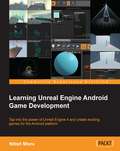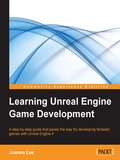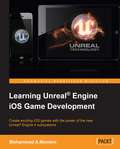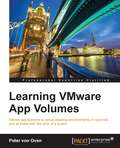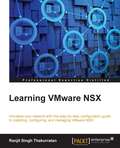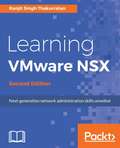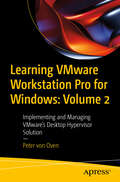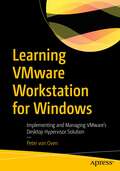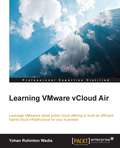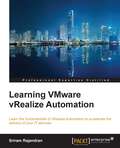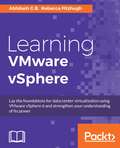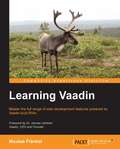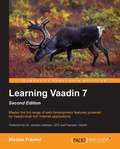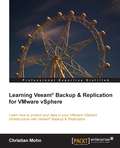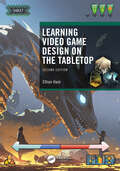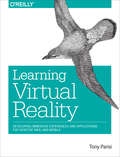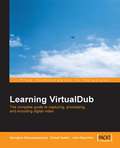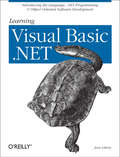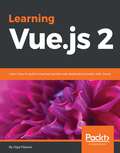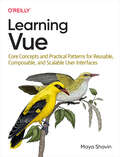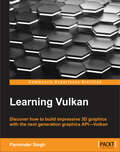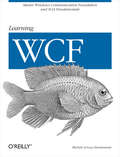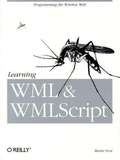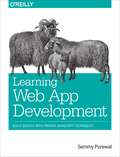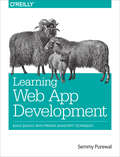- Table View
- List View
Learning Unreal Engine Android Game Development
by Nitish MisraIf you are a game developer, designer, artist, or a beginner in the gaming industry and want to make Android games with Unreal Engine 4 efficiently, this book is ideal for you.
Learning Unreal Engine Game Development
by Joanna LeeA step-by-step guide that paves the way for developing fantastic games with Unreal Engine 4 About This Book * Learn about game development and the building blocks that go into creating a game * A simple tutorial for beginners to get acquainted with the Unreal Engine architecture * Learn about the features and functionalities of Unreal Engine 4 and how to use them to create your own games Who This Book Is For If you are new to game development and want to learn how games are created using Unreal Engine 4, this book is the right choice for you. You do not need prior game development experience, but it is expected that you have played games before. Knowledge of C++ would prove to be useful. What You Will Learn * Learn what a game engine is, the history of Unreal Engine, and how game studios create games * Explore the Unreal Engine 4 editor controls and learn how to use the editor to create a room in a game level * Understand the basic structures of objects in a game, such as the differences between BSP and static meshes * Make objects interactive using level blueprints * Learn more about computer graphics rendering; how materials and light are rendered in your game * Get acquainted with the Material Editor to create materials and use different types of lights in the game levels * Utilize the various editors, tools, and features such as UI, the particle system, audio, terrain manipulation, and cinematics in Unreal Engine 4 to create game levels In Detail Unreal Engine 4 is a powerful game development engine that provides rich functionalities to create 2D and 3D games across multiple platforms. Many people know what a game is and they play games every day, but how many of them know how to create a game? Unreal Engine technology powers hundreds of games, and thousands of individuals have built careers and companies around skills developed using this engine. Learning Unreal Engine 4 Game Development starts with small, simple game ideas and playable projects that you can actually finish. The book first teaches you the basics of using Unreal Engine to create a simple game level. Then, you'll learn how to add details such as actors, animation, effects, and so on to the game. The complexity will increase over the chapters and the examples chosen will help you learn a wide variety of game development techniques. This book aims to equip you with the confidence and skills to design and build your own games using Unreal Engine 4. By the end of this book, you'll have learnt about the entire Unreal suite and know how to successfully create fun, simple games. Style and approach This book explains in detail what goes into the development of a game, provides hands-on examples that you can follow to create the different components of a game, and provides sufficient background/theory to equip you with a solid foundation for creating your own games.
Learning Unreal® Engine iOS Game Development
by Muhammad A. MoniemIf you are a game developer, designer, artist, or a beginner in the gaming industry, and want to make iOS games efficiently at a low cost, this book is ideal for you.
Learning VMware App Volumes
by Peter Von OvenThis book is for administrators and IT teams who would like to take full advantage of App Volumes to deal with application workloads. It will also be useful for virtualization professionals and teams who are working on VDI deployments and VMware end user computing solutions.
Learning VMware NSX
by Ranjit SinghThis book is for those who want to learn to install, manage, and configure VMware NSX Network Virtualization platform. You may want to explore and understand VMware NSX, are ready to deploy NSX in your environment, or are preparing for NSX certification. Knowledge of basic networking concepts and VMware components such as vCenter and vSphere is required.
Learning VMware NSX, Second Edition
by Ranjit Singh ThakurratanVMware NSX is a platform for the software-defined data center. The book allows you a thorough understanding of implementing Software defined networks using VMware’s NSX. You will get a brief overview of the NSX Core Components NSX’s basic architecture. Once you are familiar with everything, you will get to know how to deploy various NSX features. Furthermore, you will understand how to manage and monitor NSX and its associated services and features.
Learning VMware Workstation Pro for Windows: Implementing and Managing VMware’s Desktop Hypervisor Solution
by Peter von OvenVMware Workstation is a software solution that provides a type-2 hypervisor, or desktop hypervisor, that runs on x64 Windows and Linux-based operating systems. It enables users to create and run virtual machines, containers, and Kubernetes clusters simultaneously on their physical devices without having to reformat or dual-boot the underlying device. There are several use cases for VMware Workstation. For IT pros, it allows them to test applications and operating system builds, as well as enable remote control of vSphere datacenter infrastructure. Developers can run multiple different operating systems or different versions of operating systems on a single device giving them the platform flexibility to test, develop, and troubleshoot applications cost-effectively. Finally, for the greater workforce, VMware Workstation can enable BYOD device initiatives allowing employees to run a full corporate environment on their device without deleting or reformatting it. Learning VMware Workstation Pro for Windows – Part 2 provides the reader with a practical, step-by-step guide to creating and managing virtual machines using VMware Workstation, starting with an overview of hypervisors and desktop hypervisors. Next, it talks about each resource, such as CPU, memory, and networking, and how these are configured in a virtual environment. After that, it demonstrates the installation of VMware Workstation, configuration, and then building and managing different virtual machines running on different operating systems such as ChromeOS, and Linux, and building an ESXi lab environment. Towards the end, readers will learn how to use command line tools, such as the REST API, and vmrun, before going on to discuss upgrading and troubleshooting your VMware Workstation environment. By the end of this book, readers will have full knowledge of VMware Workstation Pro. This book is a continuation of " Learning VMware Workstation Pro for Windows – Part 1 " where readers learn how to build and manage different virtual machines running on different operating systems and build an ESXi lab environment with VMware Workstation. You Will: Learn how to run containers on a VMware workstation Understand how to use the command line to configure and control Workstation Pro and virtual machines Practice the use of REST API for Workstation Pro This book is for: Developers, IT professionals, VMware certified professionals both remote and Bring your device (BYOD).
Learning VMware Workstation for Windows: Implementing and Managing VMware’s Desktop Hypervisor Solution
by Peter von OvenMaster VMware Workstation to create and run virtual machines, containers, and Kubernetes clusters simultaneously on physical devices without having to reformat or dual boot the underlying device. This book provides a practical, step-by-step guide to creating and managing virtual machines using VMware Workstation, a software solution that provides a type-2 hypervisor, or desktop hypervisor, that runs on x64 Windows and Linux-based operating systems. This book focuses on the Windows version.You’ll start with an overview of hypervisors and desktop hypervisors. You'll then look at resources, such as CPU, memory, and networking, and how they are configured in a virtual environment. In the final chapters, you’ll learn how to configure Workstation Pro to run and manage virtual machines before going on to build example virtual machines, including how to build a nested vSphere environment. Once built you’ll see how to manage these virtual machines, before finally upgrading your VMware Workstation Pro environment. In the end, you’ll learn how to build and manage different virtual machines running on different operating systems and build an ESXi lab environment with VMware Workstation. What You'll Learn Examine hypervisors and desktop hypervisorsUnderstand how to install and configure VMware WorkstationGain practical knowledge on building and managing virtual machines on different OSsSupport and troubleshoot VMware Workstation environments. Who This Book Is For Developers, IT professionals that remote, home, and BYOD
Learning VMware vCloud Air
by Yohan Rohinton WadiaThis book is intended for cloud engineers or administrators who wish to explore and gain hands-on experience of VMware vCloud Air.<P><P> To make the most of this book, it would be beneficial to have a bit of familiarity with basic VMware vCloud concepts, but no prior experience is required.
Learning VMware vRealize Automation
by Sriram RajendranLearn the fundamentals of vRealize Automation to accelerate the delivery of your IT services About This Book * Learn to install the vRealize Automation product in a distributed architecture using a load balancer * Plan backup and recovery strategies for every vRealize automation component * Use vRealize Automation to manage applications and improve operational efficiency using this simple and intuitive guide Who This Book Is For This book is for anyone who wants to start their journey with vRealize Automation. It is your one-stop instruction guide to installing and configuring a distributed setup using NSX load balancer. Regardless of whether or not you have used vRealize Automation before, following the steps provided in each chapter will get you started with the product. What You Will Learn * Understand the basic building blocks of vRealize Automation before embarking on the journey of installation * Familiarize yourself with the requirements and steps that need to be performed during the first phase of the distributed installation * Carry out a functional validation of the first phase of installation before completing the installation * Build a blueprint for vSphere endpoint, an essential step for a successful deployment of a service catalog * Create, configure, and deploy tenants, endpoints, blueprints, and the service catalog * Get to grips with the failover process for all components in vRealize Automation * Learn to configure the NSX loadbalancer for vRealize Orchestrator for high availability * Leverage ASD to develop XaaS (Anything as a Service) in vRealize Automation to deliver valuable competence In Detail With the growing interest in Software Defined Data Centers (SDDC), vRealize Automation offers data center users an organized service catalog and governance for administrators. This way, end users gain autonomy while the IT department stays in control, making sure security and compliance requirements are met. Learning what each component does and how they dovetail with each other will bolster your understanding of vRealize Automation. The book starts off with an introduction to the distributed architecture that has been tested and installed in large scale deployments. Implementing and configuring distributed architecture with custom certificates is unarguably a demanding task, and it will be covered next. After this, we will progress with the installation. A vRealize Automation blueprint can be prepared in multiple ways; we will focus solely on vSphere endpoint blueprint. After this, we will discuss the high availability configuration via NSX loadbalancer for vRealize Orchestrator. Finally, we end with Advanced Service Designer, which provides service architects with the ability to create advanced services and publish them as catalog items. Style and approach This book takes a step-by-step approach, is explained in a conversational and easy-to-follow style, and includes ample screenshots . Each topic is explained sequentially through planning, preparing, installing, configuring, and validating of all vRealize Automation's components.
Learning VMware vSphere
by Rebecca Fitzhugh Abhilash G BLay the foundations for data center virtualization using VMware vSphere 6 and strengthen your understanding of its power About This Book * Learn how server virtualization is achieved and how a virtual infrastructure is built using VMware's products and solutions. * Design to create a scalable and responsive virtualization platform for hosting the virtual machine workloads of a business. Manage compute, network and storage resources of a virtual infrastructure. * Relevant conceptual diagrams, flowcharts and screen-captures enable in-depth comprehension of the concepts. Also, the concise writing style makes this book a very easy read. Who This Book Is For This is a book for any experienced technologist who is new to the realm of Data Center virtualization wanting to find a way to get a head start in learning how to design, implement and manage a modern day datacenter virtualized using VMware's core infrastructure solutions. It could also act a comprehensive reference guide for Infrastructure Architects and System Administrators to aid them in their day to day activities. This book could easily find its place in reference materials used by professionals for VCP and VCAP certification exams. Keep in mind however that the book is not written to follow as a blueprint for either of the exams. What You Will Learn * Understand the architecture of the hypervisor and learn how to install deploy and configure ESXi hosts * Find out what forms a VMware Virtual Machine can take and also learn how to create and manage them * Familiarize yourself with the concepts of vSphere Storage and learn how to present and manage storage in a vSphere environment * Create and manage software switching constructs such as the vNetwork Standard Switch and vNetwork Distributed Switches * Monitor the performance of a vSphere environment using tools such as the vCenter Performance Graphs and 'esxtop' * Manage SSL certificates in a vSphere environment * Upgrade and patch a vSphere environment using vSphere Update Manager In Detail Computer virtualization is a method to enable the running of multiple application workloads on a machine to achieve efficient utilization and reduce the number of physical machines in a data center. This has now become the foundation of many modern day data centers. What began as a technology to virtualize x86 architecture has now grown beyond the limits of a server's hardware and into the realm of storage and network virtualization. VMware is currently the market leader in developing data center virtualization solutions. This book goes into the details of designing and implementing VMware solutions that form the foundation of a VMware infrastructure. The book begins by introducing you to the concepts of server virtualization followed by the architecture of VMware's hypervisor - ESXi and then by its installation and configuration. You then learn what is required to manage a vSphere environment and configure advanced management capabilities of vCenter. Next you are taken through topics on vSphere Networking, Storage, ESXi Clustering, Resource Management and Virtual Machine Management. You will then be introduced to SSL Certificate Management and its use in a vSphere environment. Finally, you will learn about the lifecycle management of a vSphere environment by effectively monitoring, patching and upgrading vSphere components using Update Manager. By the end of the book, you will know how to use VMware's vSphere suite of components to lay the foundation of a modern day virtual infrastructure. Style and approach This is an easy-to-follow guide that will give you everything you need to fully understand the concepts involved in data center virtualization. The screenshots, concept diagrams, and flowcharts included will help you understand the subjects discussed better.
Learning Vaadin 7
by Nicolas FrankelThis book begins with a tutorial on Vaadin 7, followed by a process of planning, analyzing, building, and deploying a fully functional RIA while covering troubleshooting details along the way, making it an invaluable resource for answers to all your Vaadin questions.If you are a Java developer with some experience in development either on JSP/Servlet or on Swing, and want to enter the world of rich Internet applications, then this technology and book is ideal for you. Learning Vaadin will be perfect as your next step towards building eye-catching, dynamic web applications on a Java-based platform.
Learning Vaadin 7: Second Edition
by Nicolas FrankelThis book begins with a tutorial on Vaadin 7, followed by a process of planning, analyzing, building, and deploying a fully functional RIA while covering troubleshooting details along the way, making it an invaluable resource for answers to all your Vaadin questions.If you are a Java developer with some experience in development either on JSP/Servlet or on Swing, and want to enter the world of rich Internet applications, then this technology and book is ideal for you. Learning Vaadin will be perfect as your next step towards building eye-catching, dynamic web applications on a Java-based platform.
Learning Veeam® Backup & Replication for VMware vSphere
by Christian MohnThis is an easy-to-follow guide that will help you learn everything you need to know to administer backup, replication, and recovery in your VMware vSphere environment, with Veeam Backup and Replication. This book is aimed at VMware vSphere administrators looking to protect their infrastructure by utilizing the world's leading modern data protection solution, specifically designed for virtual environments. A good understanding of VMware vSphere architecture is recommended, but prior knowledge of Veeam Backup and Replication is not required.
Learning Video Game Design on the Tabletop
by Ethan HamLearn the mechanics that take your game from an idea to a playable product.Do you aspire to be a game designer but aren’t sure where to begin? Learning Video Game Design on the Tabletop guides you through your initial attempts to design game mechanics. It goes beyond simple description and definition to explore in detail the issues that designers grapple with for every game they create.Learning to design tabletop games builds a solid foundation for game designers and provides methods that can be applied towards creating paper prototypes of computer-targeted games. Presented in a step-by-step format, this book helps the reader understand how the game design skills that are acquired through creating tabletop games can be used when designing video games. Fully playable games accompany every topic so you can truly understand and experience each component that goes into game creation.The Second Edition includes: Simple, highly focused games that can be played, analyzed, improved, and/or modified in conjunction with a particular topic in the book Integrated game design exercises, chapter learning objectives, and in-text sidebars to provide further examples to apply directly to your game creation process Essays from professional tabletop and video game designers in which they describe their professional journeys and design philosophies.
Learning Virtual Reality: Developing Immersive Experiences and Applications for Desktop, Web, and Mobile
by Tony ParisiAs virtual reality approaches mainstream consumer use, a vibrant development ecosystem has emerged in the past few years. This hands-on guide takes you through VR development essentials for desktop, mobile, and browser-based applications. You’ll explore the three go-to platforms—OculusVR, Gear VR, and Cardboard VR—as well as several VR development environments, programming tools, and techniques.If you’re an experienced programmer familiar with mobile development, this book will help you gain a working knowledge of VR development through clear and simple examples. Once you create a complete application in the final chapter, you’ll have a jumpstart on the next major entertainment medium.Learn VR basics for UI design, 3D graphics, and stereo renderingExplore Unity3D, the current development choice among game enginesCreate native applications for desktop computers with the Oculus RiftDevelop mobile applications for Samsung’s Gear VR with the Android and Oculus Mobile SDKsBuild browser-based applications with the WebVR Javascript API and WebGLCreate simple and affordable mobile apps for any smartphone with Google’s Cardboard VRBring everything together to build a 360-degree panoramic photo viewer
Learning VirtualDub: The complete guide to capturing, processing and encoding digital video
by Sohail Salehi Georgios DiamantopoulosThis book is easy to read and fun. The examples and tutorials are short, focused and interesting. You can dip in and get what you want fast. This book is written by VirtualDub enthusiasts for new and intermediate users. It's ideal if you are just starting with video processing and want a powerful and free tool, or if you've already started with VirtualDub and want to take it further.
Learning Visual Basic .NET: Introducing the Language, .NET Programming & Object Oriented Software Development
by Jesse LibertyMost Visual Basic .NET books are written for experienced object-oriented programmers, but many programmers jumping on the .NET bandwagon are coming from non-object-oriented languages, such as Visual Basic 6.0 or from script programming, such as JavaScript. These programmers, and those who are adopting VB.NET as their first programming language, have been out of luck when it comes to finding a high-quality introduction to the language that helps them get started.That's why Jesse Liberty, author of the best-selling books Programming C# and Programming ASP.NET, has written an entry-level guide to Visual Basic .NET. Written in a warm and friendly manner, this book assumes no prior programming experience, and provides an easy introduction to Microsoft's most popular .NET language.Learning Visual Basic .NET is a complete introduction to VB.NET and object-oriented programming. This book will help you build a solid foundation in .NET, and show how to apply your skills by using hundreds of examples to help you become productive quickly. Learning Visual Basic .NET introduces fundamentals like Visual Studio .NET, a tool set for building Windows and Web applications. You'll learn about the syntax and structure of the Visual Basic .NET language, including operators, classes and interfaces, structs, arrays, and strings. Liberty then demonstrates how to develop various kinds of applications--including those that work with databases--and web services.By the time you've finished Learning Visual Basic .NET, you'll be ready to move on to a more advanced programming guide that will help you create large-scale web and Windows applications.Whether you have a little object-oriented programming experience or you are new to programming altogether, Visual Basic .NET will set you firmly on your way to mastering the essentials of the VB.NET language.
Learning Vue.js 2
by Olga FilipovaLearn how to build amazing and complex reactive web applications easily with Vue.js About This Book • Learn how to propagate DOM changes across the website without writing extensive jQuery callbacks code. • Learn how to achieve reactivity and easily compose views with Vue.js and understand what it does behind the scenes. • Explore the core features of Vue.js with small examples, learn how to build dynamic content into preexisting web applications, and build Vue.js applications from scratch. Who This Book Is For This book is perfect for novice web developer seeking to learn new technologies or frameworks and also for webdev gurus eager to enrich their experience. Whatever your level of expertise, this book is a great introduction to the wonderful world of reactive web apps. What You Will Learn • Build a fully functioning reactive web application in Vue.js from scratch. • The importance of the MVVM architecture and how Vue.js compares with other frameworks such as Angular.js and React.js. • How to bring reactivity to an existing static application using Vue.js. • How to use plugins to enrich your applications. • How to develop customized plugins to meet your needs. • How to use Vuex to manage global application's state. In Detail Vue.js is one of the latest new frameworks to have piqued the interest of web developers due to its reactivity, reusable components, and ease of use. This book shows developers how to leverage its features to build high-performing, reactive web interfaces with Vue.js. From the initial structuring to full deployment, this book provides step-by-step guidance to developing an interactive web interface from scratch with Vue.js. You will start by building a simple application in Vue.js which will let you observe its features in action. Delving into more complex concepts, you will learn about reactive data binding, reusable components, plugins, filters, and state management with Vuex. This book will also teach you how to bring reactivity to an existing static application using Vue.js. By the time you finish this book you will have built, tested, and deployed a complete reactive application in Vue.js from scratch. Style and approach This book is a thorough, step-by-step guide showing readers how to build complete web apps with Vue.js. While teaching its intricacies, this book shows how to implement the MVVM architecture in the real world and build high-performing web interfaces.
Learning Vue: Core Concepts and Practical Patterns for Reusable, Composable, and Scalable User Interfaces
by Maya ShavinLearn the core concepts of Vue.js, the modern JavaScript framework for building frontend applications and interfaces from scratch. With concise, practical, and clear examples, this book takes web developers step-by-step through the tools and libraries in the Vue.js ecosystem and shows them how to create complete applications for real-world web projects.You’ll learn how to handle data communication between components with Pinia architecture, develop a manageable routing system for a frontend project to control the application flow, and produce basic animation effects to create a better user experience.This book also shows you how to:Create reusable and lightweight component systems using Vue.jsBring reactivity to your existing static applicationSet up a project using Vite.js, a build tool for frontend project code managementBuild an interactive state management system for a frontend application with PiniaConnect external data from the server to your Vue applicationControl the application flow with static and dynamic routing using Vue RouterFully test your application using Vitest and Playwright
Learning Vulkan
by Parminder SinghDiscover how to build impressive 3D graphics with the next-generation graphics API—Vulkan About This Book • Get started with the Vulkan API and its programming techniques using the easy-to-follow examples to create stunning 3D graphics • Understand memory management in Vulkan and implement image and buffer resources • Get hands-on with the drawing process and synchronization, and render a 3D graphics scene with the Vulkan graphics pipeline Who This Book Is For This book is ideal for graphic programmers who want to get up and running with Vulkan. It's also great for programmers who have experience with OpenGL and other graphic APIs who want to take advantage of next generation APIs. A good knowledge of C/C++ is expected. What You Will Learn • Learn fundamentals of Vulkan programing model to harness the power of modern GPU devices. • Implement device, command buffer and queues to get connected with the physical hardware. • Explore various validation layers and learn how to use it for debugging Vulkan application. • Get a grip on memory management to control host and device memory operations. • Understand and implement buffer and image resource types in Vulkan. • Define drawing operations in the Render pass and implement graphics pipeline. • Manage GLSL shader using SPIR-V and update the shader resources with descriptor sets and push constants. • Learn the drawing process, manage resources with synchronization objects and render 3D scene output on screen with Swapchain. • Bring realism to your rendered 3D scene with textures, and implement linear and optimal textures In Detail Vulkan, the next generation graphics and compute API, is the latest offering by Khronos. This API is the successor of OpenGL and unlike OpenGL, it offers great flexibility and high performance capabilities to control modern GPU devices. With this book, you'll get great insights into the workings of Vulkan and how you can make stunning graphics run with minimum hardware requirements. We begin with a brief introduction to the Vulkan system and show you its distinct features with the successor to the OpenGL API. First, you will see how to establish a connection with hardware devices to query the available queues, memory types, and capabilities offered. Vulkan is verbose, so before diving deep into programing, you'll get to grips with debugging techniques so even first-timers can overcome error traps using Vulkan's layer and extension features. You'll get a grip on command buffers and acquire the knowledge to record various operation commands into command buffer and submit it to a proper queue for GPU processing. We'll take a detailed look at memory management and demonstrate the use of buffer and image resources to create drawing textures and image views for the presentation engine and vertex buffers to store geometry information. You'll get a brief overview of SPIR-V, the new way to manage shaders, and you'll define the drawing operations as a single unit of work in the Render pass with the help of attachments and subpasses. You'll also create frame buffers and build a solid graphics pipeline, as well as making use of the synchronizing mechanism to manage GPU and CPU hand-shaking. By the end, you'll know everything you need to know to get your hands dirty with the coolest Graphics API on the block. Style and approach This book takes a practical approach to guide you through the Vulkan API, and you will get to build an application throughout the course of the book. Since you are expected to be familiar with C/C++, there is not much hand-holding throughout the course of the book.
Learning WCF: A Hands-on Guide
by Michele Leroux BustamanteThis easy-to-use introduction to Microsoft Windows Communication Foundation (WCF) is ideal for developers who want to learn to build services on a company network or as part of an enterprise system. Built into Windows Vista and Longhorn, and available for Windows XP and Windows 2003, WCF provides a platform for service-oriented architecture (SOA) that enables secure and reliable communication among systems within an organization or across the Internet. With WCF, software developers can focus on their business applications and not the plumbing required to connect them. Furthermore, with WCF developers can learn a single programming API to achieve results previously provided by ASMX, Enterprise Services and .NET Remoting. Learning WCF removes the complexity of using this platform by providing detailed answers, explanations and code samples for the most common questions asked by software developers.Windows Communication Foundation (or WCF, formerly code name "Indigo") provides a set of programming APIs that make it easy to build and consume secure, reliable, and transacted services. This platform removes the need for developers to learn different technologies such as ASMX, Enterprise Services and .NET Remoting, to distribute system functionality on a corporate network or over the Internet. The first truly service-oriented platform, WCF provides innovations that decouple service design and development from deployment and distribution - creating a more flexible and agile environment. WCF also encapsulates all of the latest web service standards for addressing, security, reliability and more.
Learning WML & WMLScript
by Martin FrostThe next generation of mobile communicators is here, and delivering content to them will mean programming in WML (Wireless Markup Language) and WMLScript, the languages of the Wireless Application Environment (WAE). The WAE allows information in almost all applications to be formatted for display on mobile devices, such as cell phones, and enables the user to interact with the information. Why learn yet another technology? According to some estimates, 75 percent of web document viewing by the year 2002 will be through non-desktop devices, many using wireless technologies. Clearly, the future is wireless. For web developers who want to get up to speed quickly in these languages, Learning WML & WMLScript maps out in detail the WAE and its two major components, WML and WMLScript. Fortunately, the WAE provides a World Wide Web-like model for writing applications, incorporating several key features of the Web to ease the transition for developers. Almost all wireless applications can be written with WML, which replaces HTML in the wireless environment, and WMLScript, which replaces JavaScript. With this book, web developers with some knowledge of programming and C, Java, or JavaScript syntax can easily master both languages. Chapter by chapter, Learning WML & WMLScript takes readers through the following WML topics: *Decks, templates and cards *User Interaction *Variables and contexts *Tasks, events, and timers *Text and text formatting *Data types, conversions and variables *Operators and expressions *Statements *Functions *Standard libraries. WMLScript topics include: Learning WML & WMLScript is the resource of choice for application developers who want to upgrade their skills and their sites so they won't be left plugged in during the wireless revolution.
Learning Web App Development
by Semmy PurewalGrasp the fundamentals of web application development by building a simple database-backed app from scratch, using HTML, JavaScript, and other open source tools. Through hands-on tutorials, this practical guide shows inexperienced web app developers how to create a user interface, write a server, build client-server communication, and use a cloud-based service to deploy the application. Each chapter includes practice problems, full examples, and mental models of the development workflow. Ideal for a college-level course, this book helps you get started with web app development by providing you with a solid grounding in the process. Set up a basic workflow with a text editor, version control system, and web browser Structure a user interface with HTML, and include styles with CSS Use JQuery and JavaScript to add interactivity to your application Link the client to the server with AJAX, JavaScript objects, and JSON Learn the basics of server-side programming with Node. js Store data outside your application with Redis and MongoDB Share your application by uploading it to the cloud with CloudFoundry Get basic tips for writing maintainable code on both client and server
Learning Web App Development
by Semmy PurewalGrasp the fundamentals of web application development by building a simple database-backed app from scratch, using HTML, JavaScript, and other open source tools. Through hands-on tutorials, this practical guide shows inexperienced web app developers how to create a user interface, write a server, build client-server communication, and use a cloud-based service to deploy the application.Each chapter includes practice problems, full examples, and mental models of the development workflow. Ideal for a college-level course, this book helps you get started with web app development by providing you with a solid grounding in the process.Set up a basic workflow with a text editor, version control system, and web browserStructure a user interface with HTML, and include styles with CSSUse JQuery and JavaScript to add interactivity to your applicationLink the client to the server with AJAX, JavaScript objects, and JSONLearn the basics of server-side programming with Node.jsStore data outside your application with Redis and MongoDBShare your application by uploading it to the cloud with CloudFoundryGet basic tips for writing maintainable code on both client and server
